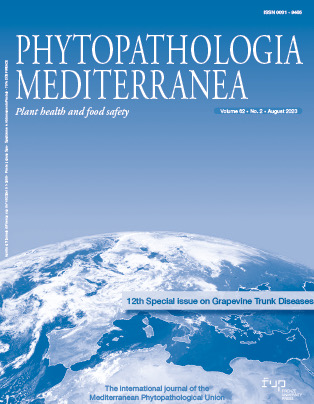Grapevine dieback caused by Botryosphaeriaceae species, Paraconiothyrium brasiliense, Seimatosporium vitis-viniferae and Truncatella angustata in Piedmont: characterization and pathogenicity
Published 2023-09-15
Keywords
- Botryosphaeria dieback,
- Diplodia mutila,
- Neocucurbitaria juglandicola,
- pathogenicity,
- Grapevine Trunk Diseases
How to Cite
Copyright (c) 2023 Greta DARDANI, Laura MUGNAI, Simone BUSSOTTI, M. Lodovica GULLINO, Vladimiro GUARNACCIA

This work is licensed under a Creative Commons Attribution 4.0 International License.
Abstract
Grapevine Trunk Diseases (GTDs) are major threats in Mediterranean countries, causing economic losses due to reduced grape yields and long-term vine productivity, as well as death of grapevines. A survey was conducted in Piedmont (Northern Italy) during 2021-2022 to investigate the species diversity and distribution of GTD pathogens in this important Italian wine region. Morphological and multi-locus phylogenetic analyses (based on ITS, tef1, tub2, act and rpb2) identified species of Botryosphaeriaceae at high frequency, including Botryosphaeria dothidea, Diplodia mutila, Diplodia seriata and Neofusicoccum parvum. Other pathogens commonly associated with GTDs, including Eutypa lata, Fomitiporia mediterranea and Phaeomoniella chlamydospora, were also isolated. Less commonly isolated species included Neocucurbitaria juglandicola, Paraconiothyrium brasiliense, Seimatosporium vitis-viniferae and Truncatella angustata. Pathogenicity tests with two representative isolates of each species were carried out using one-year-old potted grapevine cuttings (‘Barbera’). All isolates (except N. juglandicola) caused brown wood necrotic vascular discolourations on inoculated plants and were successfully re-isolated. Effects of temperature on colony growth were also assessed. For all tested isolates there was no growth at 5°C, only four isolates (Botryosphaeriaceae) grew at 35°C, and optimum growth temperatures were between 20 and 25°C. This is the first record of Paraconiothyrium brasiliense and Neocucurbitaria juglandicola associated with symptomatic grapevines in Italy.






